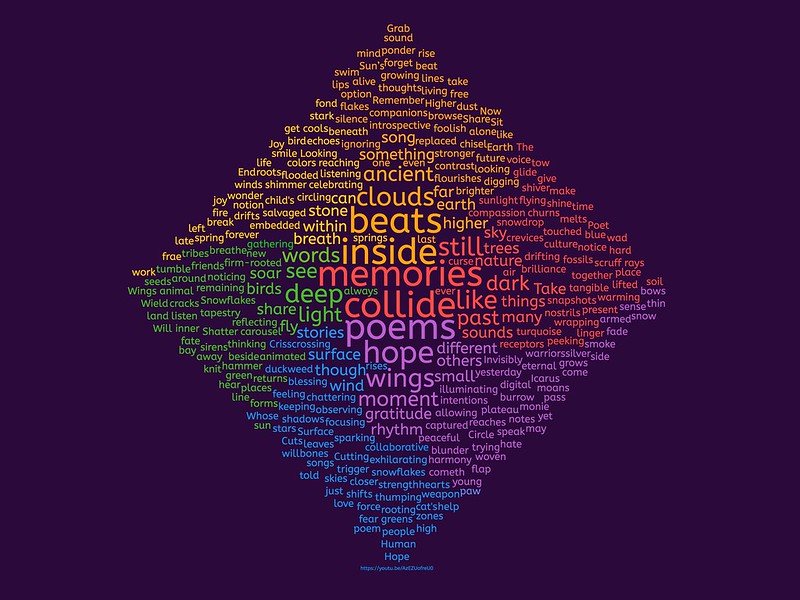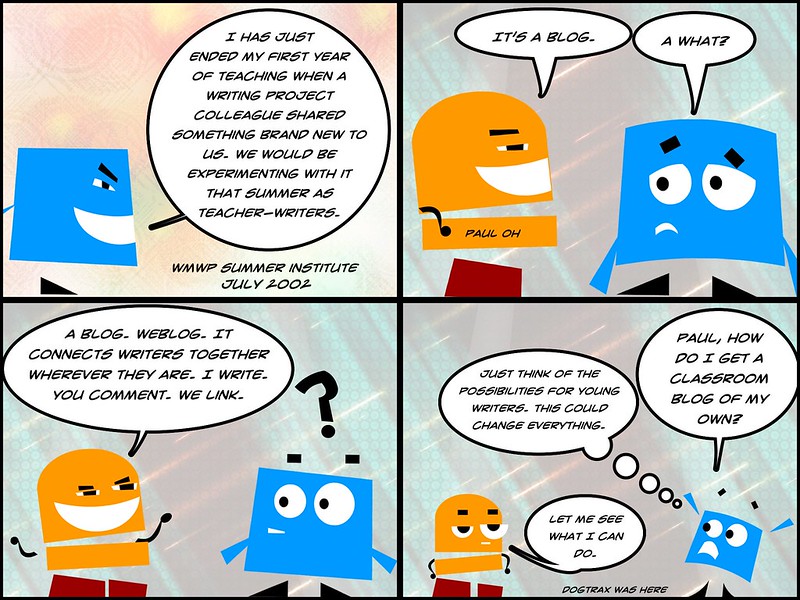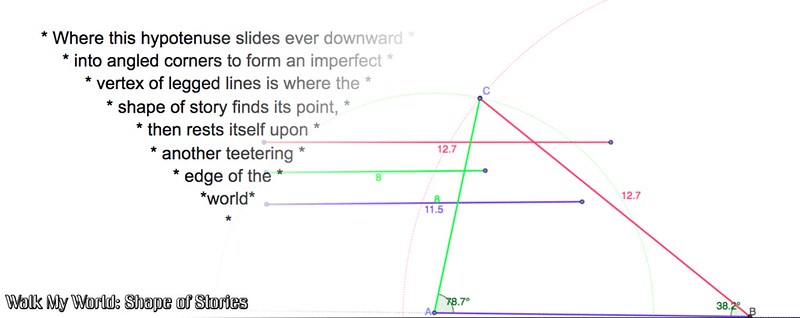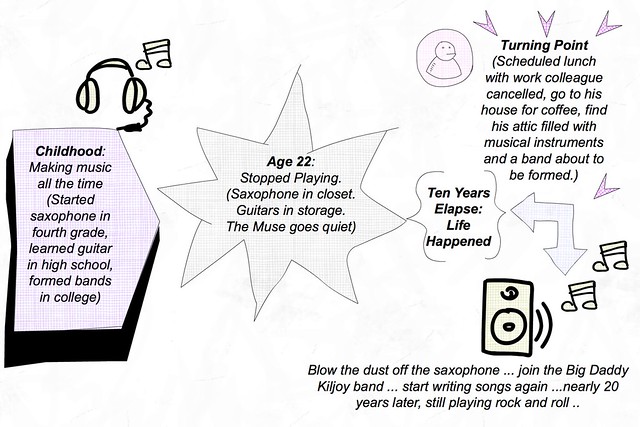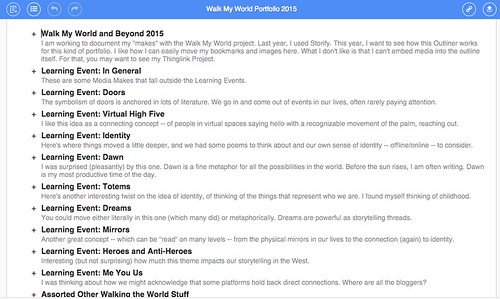My CLMOOC friend, Wendy, released a mixed audio quilt of our collective voices reading a collective poem written for the DS106 community called 106 Lines of Thought. Walk My World’s recent Learning Event (6) is to pay attention to the sound of our world, to notice the details. The audio quilt is yet further iteration of the collaboration.
So I’m going to listen and jot notes and first impressions about the voices I am hearing on the audio file …. While I may know and recognize some voices, I am not going to identify anyone until the very end … I have my headphones on and I am in deep listening space … writing what I hear …
- First Voice — first some claves then a short remix edit repeat of the 106 theme … clear and passionate, an introduction to listen … a personal voice … a collaborative reading … guitar bridge
- Second Voice — the alliterative patterns in the first stanza of the poem, read so lovely by this voice … the bird the stars the shimmer … the texture of her voice is a nice frequency for the words here
- Third Voice — familiar voice familiar words … trying to find some emotional elements underneath the lines … the break through … the moment … false ending …. this is not the ending
- Fourth Voice — music interlude … the accent draws me in, familiar and yet not heard by my ears on a daily basis kind of accent, there’s a sharpness to the dark wings .. higher higher higher, and the voice hit an emotional shift to bring us up, only to be reminded of the fate of Icarus
- Fifth Voice — warmth here on the first phrase of words .. warming the bones .. looking down … and then, gratitude .. I am leaning into the sound of the warmth now … observing the moment …
- Sixth Voice — nearly no gap space before this voice takes the poem from before like a baton pass and holds out for our hand, bringing us forward … sparking something deep inside … of you us we .. reaching out to others …
- Seventh Voice — percussive interlude with claves … click click click – the musical thread, perhaps, or the ink of the poem to be read … I am sitting here at the table, sitting with this voice, so close now it seems in sound and so rich with ambience … listening, always listening … the small things … these give us all hope …
- Eighth Voice — pace of narration quickens a bit, captured like snapshots to browse through … I imagine us all doing that here, the collective urge to remember something important before we forget … wings rhythm beat ..
- Ninth Voice — sounds of wings continue, a voice from a soft tunnel, perhaps, or a protective cave, or some chamber in dusk or dawn where the voice is a friendly token, something you find … tribes gathering …
- Tenth Voice — textured range of voice, a small token or trinket reminding us of love and compassion, and I am visualizing the text here as I am hearing the text …
- Eleventh Voice — the percussive ink returns, a rhythmic reminder of the threads that connect the voices together … the voice is close and yet also far, wrapped in a blanket of soft noise … the snowflakes drifting in the wind .. a poet’s voice, texture and tenor
- Twelfth Voice — questioning? confidence. A voice of dust. A shape emerges from the poem here, the rhymes and voice of a storyteller … reminding the audience of something larger emerging from the small pieces of words
- Thirteenth Voice — I imagine being in a listening hall, a poet sitting on the stage, their voice working working to pull me forward, to sit in the chair next to them, to listen and to wonder and to connect … to salvage hope … to listen for joy …
- Fourteenth Voice — here, now, I am adrift in the small, nearly invisible intentional currents of a lake of words … the voice is the boat, or a stick, and we are ripples … the trees and soil and the rooting of stories … and we are thinking feeling listening …
- Fifteenth Voice — the voice is running, pausing, slowing, not stopping, moving, pushing, guiding, sanding down the edges of something to reveal what’s beneath … roots burrow down
- Sixteenth Voice — spectrum of sound in this voice, past the places, the knowing understanding voice, the narrator who sees a way forward and invites us to join … like a blessing … returns
- Seventeenth Voice — an echo of an earlier voice, returns … smoke and fire …. something flourishes, even in the quickened pace of the poem …
- Eighteenth Voice — claves again, stitching .. clarity of frequency, this voice is next to us, sitting … right … there … and what will we make of this place? Indeed. What WILL we make of this place?
- Nineteenth Voice — the voice is neither, neither hammer or chisel, but more a vocalized gift of each, and we are surfacing, are we not?
- Twentieth Voice — forced slowdown for intentional alliteration, so effective so effective … my ears linger on the sound … on the tapestry … harmony …
- Twenty-First Voice — lifting voice to the question mark of text … then, the slow roll down the incline … I imagine the paint stroke of a young artist, guided by instinct and making art …
- Twenty-Second Voice — less question than a gathering … what will it be … these last lines … will we remember to breathe?
- Music outro — guitar riff, hopeful sound
Peace (in listening mode),
Kevin
PS — from Wendy at Soundcloud
Readers in order or appearance (Twitter tag): Lisa (nobleknits2) Charlene (inspirepassion) Kevin (dogtrax) Ron (ronald_2008) Sue (sueinasp) Sarah (NomadWarMachine) Denise (mrsdkrebs) Will (willgourley) Ron S (ronsamul) Betsy (BetsyCallanan) Niall (niall_barr) Wendy (wentale) Catherine (catdartnall) Joe Murphy (joefromkenyon) AK (koutropoulos) Sheri (grammasheri) Irwin (irwindev) Jennifer (JenniferDenslow) Tania (taniatorikova) Irene (IrenequStewart) Susan (SSpellmanCann)
Mixed by Wendy Taleo. Music from Zapsplats.com
Original poem: wentalearn.blogspot.com/2021/02/ds106…-thought.html
